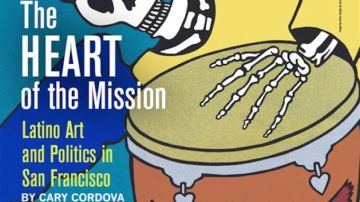New Book Shines a Light on Latino Art and Politics in San Francisco
“I was sure there wasn’t a place in the world I’d rather be, not Paris or New York

Photo: The Heart of the Mission, Mission Cultural Center for Latino Arts, Cary Cordova
“I was sure there wasn’t a place in the world I’d rather be, not Paris or New York. At that moment it seemed to me that I was standing at the artistic center of the universe…It wasn’t so much San Francisco that I fell in love with; it was the Mission, La Misión.” These are the words of poet Alejandro Murguia, after stepping foot in a 1970s Mission District.
This same Mission is in danger of becoming a thing of the past. It is a neighborhood, and moment in time, that author Cary Cordova wanted to capture in her newly-published book, The Heart of the Mission, Latino Art and Politics in San Francisco. The Mission Cultural Center for Latino Arts, recently hosted a book signing and talk with the author on her book, Latino art, culture, and more.
“This book argues for the Mission District as an important historical and geographical intersection for influential and largely undocumented pan-Latino arts movement from the 1960s to the present,” Cordova details in the introduction of her tome. The oral histories of more than 35 artists and activists are included, and not only are the heavily-referenced 1960s and ‘70s in Latino culture in San Francisco discussed, but also the 1940s, when North Beach was known as the Latin Quarter, the ‘50s, when Latinos were involved in the Beat counterculture and the avant-garde, and the 1980s, when AIDS activism was at its inception.
Cordova, a San Francisco native and assistant professor of American Studies (Center for Mexican American Studies) at The University of Texas at Austin, noted in her talk with Editor-in-Chief of Mission Local, Lydia Chavez, that many books on murals have several photos, but little text providing a backstory to the works. She decided it was necessary to delve deeper into the stories, in an “art historical way.”
One of the murals she dissects is Homage to Siqueiros, a mural by Jesus “Chuy” Campusano, Luis J. Cortazar, and Michael Rios (with additional artists), completed in 1974, and commissioned by the Bank of America. It “was so flagrantly against its host,” Cary admits to a chorus of laughs from the audience. The work, done in honor of Mexican muralist David Alfaro Siqueiros, features a crucified indigenous person, the quote by Cesar Chavez, “our sweat and our blood have fallen on this land to make other men rich,” and what can be regarded as a capitalist pig.
In addition to turning a laser focus on individual works, Cordova also looks at the women muralists, who she says were “fighting for equal representation as artists, [and as] women in the community. Their work was often seen as not political enough, they were often ignored, and the author wanted to explore the perceived dichotomy and actual duality of being “a brown woman” as well as an artist.
Probably the biggest misconception is that all Latino art in the Mission is the same. “So, I think, often, there’s a presumption, with Latino arts, that it’s going to be very didactic or political…it’s going to be very obvious, so it’s going to have a clear statement,” Cary explains. “And one of the things I wanted to create in the narrative was update that, the shift, that might not always be the case.” Many of these artists pushed themselves to work in several different genres – visual art, poetry, film, silkscreen –“so, sort of pushing the boundaries of what we think of in terms of what Latino art is, and also pushing the boundaries of what we think Latino culture is.”

















